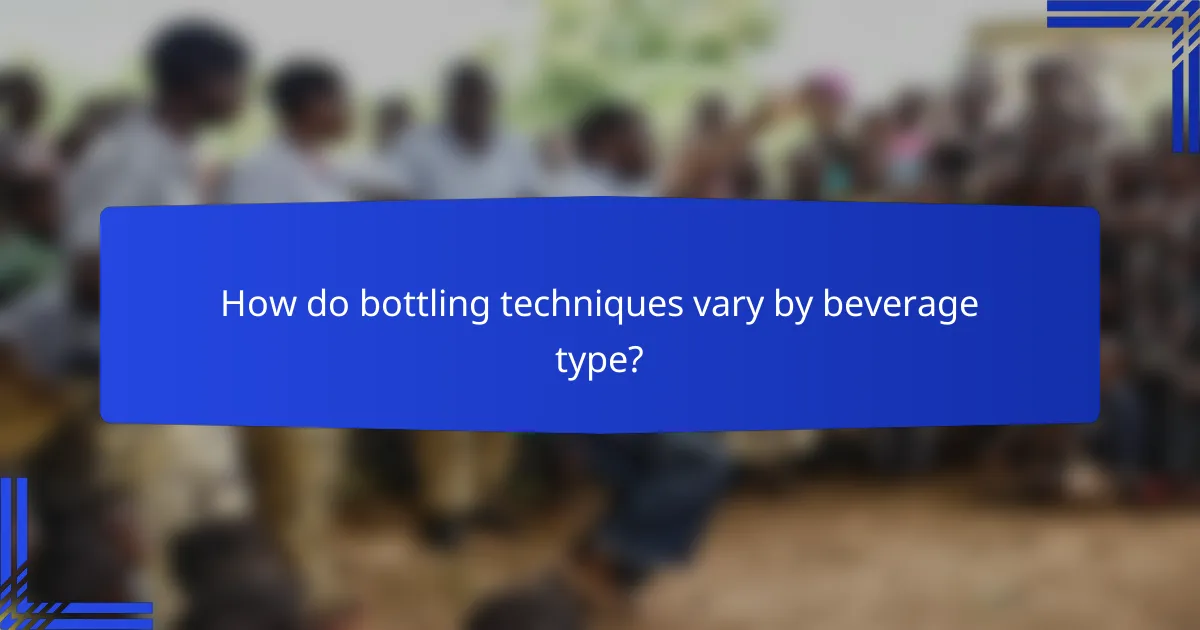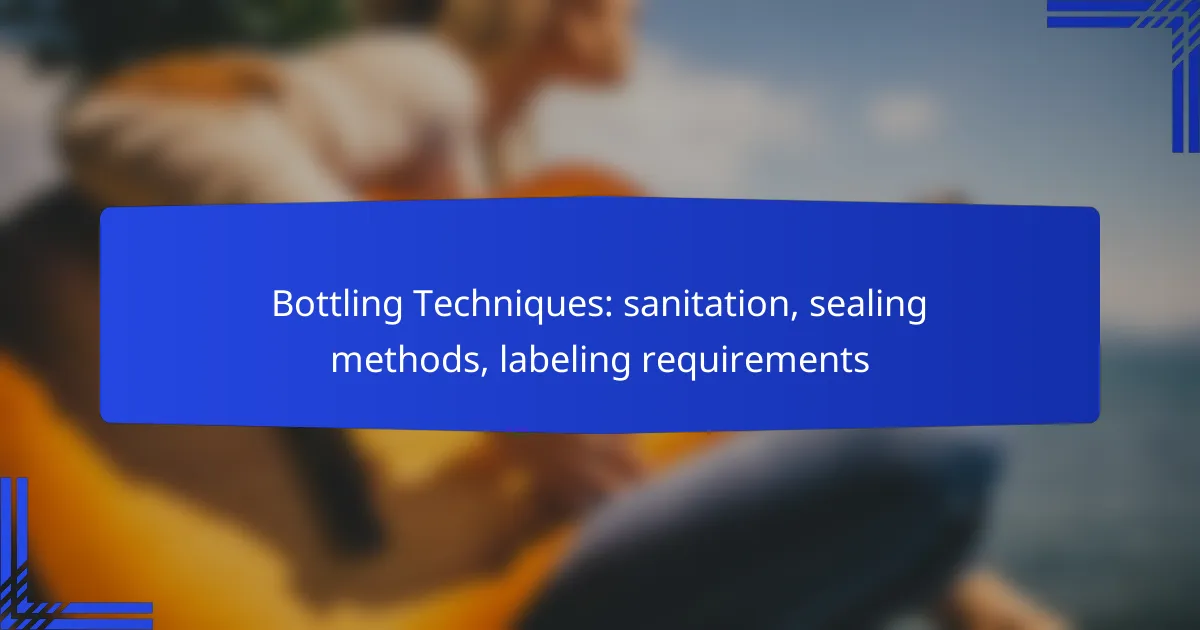Bottling techniques play a vital role in ensuring the safety and quality of beverages. Effective sanitation methods are essential to prevent contamination, while appropriate sealing techniques preserve freshness and extend shelf life. Additionally, compliance with strict labeling requirements ensures that consumers receive accurate information about the products they purchase.

What are effective bottling sanitation techniques in Australia?
Effective bottling sanitation techniques in Australia include methods that ensure cleanliness and safety in beverage production. These techniques help prevent contamination and maintain product quality, which is crucial for compliance with local health regulations.
Hot water sanitization
Hot water sanitization involves using water heated to high temperatures, typically around 80-85°C, to clean and sanitize bottles. This method is effective in killing most bacteria and pathogens without the need for chemicals, making it a preferred choice for many producers.
To implement this technique, bottles should be submerged in hot water for several minutes. Ensure that the water temperature is consistently maintained to maximize effectiveness.
Chemical sanitization
Chemical sanitization uses approved sanitizing agents, such as sodium hypochlorite or phosphoric acid, to disinfect bottles. These chemicals are effective at lower temperatures and can be used in various concentrations depending on the specific product and manufacturer guidelines.
When using chemical sanitizers, it is essential to follow the manufacturer’s instructions regarding dilution and contact time to ensure thorough sanitation. Rinse bottles with clean water after treatment to remove any residual chemicals.
Steam sanitization
Steam sanitization employs high-temperature steam to sanitize bottles effectively. This method is particularly useful for large-scale operations, as it can cover multiple bottles simultaneously and penetrate hard-to-reach areas.
To use steam sanitization, bottles should be exposed to steam for a few minutes. This technique not only sanitizes but also helps in removing any residual contaminants from the bottling process.
UV light sanitization
UV light sanitization utilizes ultraviolet light to kill microorganisms on the surface of bottles. This method is chemical-free and can be highly effective when used correctly, particularly for clear or transparent bottles.
For optimal results, bottles should be exposed to UV light for a specified duration, ensuring that all surfaces are adequately illuminated. Regular maintenance of the UV equipment is necessary to maintain its effectiveness.
Best practices for sanitation
Implementing best practices for sanitation includes regularly inspecting equipment, ensuring proper training for staff, and maintaining a clean bottling environment. Establishing a routine cleaning schedule can help prevent contamination.
Additionally, always verify that sanitizing agents are within their expiration dates and stored correctly. Keeping records of sanitation procedures can also aid in compliance with local health regulations and improve overall quality control.

How can sealing methods impact product quality?
Sealing methods significantly influence product quality by affecting freshness, shelf life, and contamination risks. Proper sealing techniques help maintain the integrity of the contents, ensuring that flavors and aromas are preserved while preventing spoilage.
Cork sealing
Cork sealing is traditionally used for wine and some spirits, providing a natural barrier against oxygen. This method allows for slight gas exchange, which can enhance aging but may also lead to cork taint if not managed properly.
When using corks, ensure they are of high quality and properly stored to avoid drying out. Consider using synthetic corks as an alternative to mitigate risks associated with natural cork.
Crown cap sealing
Crown cap sealing is commonly used for beer and soft drinks, providing an airtight seal that prevents contamination and carbonation loss. This method is effective for preserving the product’s flavor and fizziness over time.
To ensure a proper seal, check that the caps are applied with the correct pressure and that the bottles are free from debris at the sealing point. Regular quality checks can help avoid leaks and maintain product integrity.
Screw cap sealing
Screw cap sealing is increasingly popular for wines and other beverages due to its convenience and reliability. This method offers a tight seal that protects against oxidation and allows for easy opening and resealing.
When using screw caps, ensure they are compatible with the bottle design and that the sealing process is consistent. This can help maintain flavor and aroma while providing a user-friendly experience.
Vacuum sealing
Vacuum sealing removes air from the packaging, significantly extending shelf life by reducing oxidation and microbial growth. This method is often used for perishable products like food and some beverages.
For effective vacuum sealing, ensure that the packaging is designed to withstand the vacuum process. Regularly check seals for integrity to prevent air from re-entering the package.
Heat shrink sealing
Heat shrink sealing involves applying a plastic film that shrinks tightly around the container when heated, providing a tamper-evident seal. This method is commonly used for bottles and jars to enhance safety and product presentation.
When implementing heat shrink sealing, ensure the film is compatible with the product and that the heating process is controlled to avoid damaging the contents. Regular inspections can help maintain quality and appearance.

What labeling requirements must be met in Australia?
In Australia, labeling requirements are governed by strict regulations to ensure consumer safety and accurate information. Labels must include specific mandatory information and comply with standards set by Food Standards Australia New Zealand (FSANZ).
Mandatory information
Labels must clearly display essential details such as the product name, ingredients list, nutritional information, and allergen warnings. Additionally, the label should include the name and address of the manufacturer or distributor, as well as the net weight or volume of the product.
For alcoholic beverages, specific labeling requirements apply, including the alcohol content and a warning about the risks of drinking during pregnancy. This ensures consumers are well-informed about the products they purchase.
Labeling regulations by FSANZ
FSANZ oversees the food labeling regulations in Australia, ensuring that all food products meet safety and quality standards. These regulations require that labels provide truthful and not misleading information, adhering to the Australia New Zealand Food Standards Code.
Compliance with these regulations is crucial, as failure to meet labeling standards can result in penalties or product recalls. Regular updates to the code mean that businesses should stay informed about any changes that may affect their labeling practices.
Best practices for label design
Effective label design enhances product visibility and consumer understanding. Use clear fonts and contrasting colors to ensure readability, and organize information logically to guide the consumer’s eye.
Incorporating symbols or icons can help convey important information quickly, such as allergen warnings or recycling instructions. Additionally, consider the use of high-quality materials that can withstand handling and maintain the label’s integrity.
Common labeling mistakes
One frequent mistake is omitting mandatory information, which can lead to regulatory issues. Ensure that all required details are included and easily accessible on the label.
Another common error is using misleading claims or unclear language, which can confuse consumers and result in complaints. Always verify that the language used is straightforward and accurately reflects the product’s contents and benefits.

What are the prerequisites for effective bottling?
Effective bottling requires proper equipment, a clean facility, and well-trained staff. These prerequisites ensure that the bottling process maintains product integrity and meets safety standards.
Equipment selection
Choosing the right equipment is crucial for efficient bottling. Consider factors such as the type of product, production volume, and required sealing methods. For example, automated bottling lines are ideal for high-volume production, while manual systems may suffice for smaller batches.
Ensure that all equipment is compatible with the materials being bottled. For instance, glass bottles may require different handling equipment compared to plastic ones. Regular maintenance and calibration of machinery are also essential to prevent contamination and ensure consistent performance.
Facility cleanliness
A clean bottling facility is vital to prevent contamination and ensure product safety. Implement a strict cleaning schedule that includes regular sanitization of all surfaces and equipment. Use food-grade cleaning agents and follow local health regulations regarding sanitation practices.
Consider establishing designated zones for different stages of the bottling process to minimize cross-contamination. For example, separate areas for filling, capping, and labeling can help maintain cleanliness and organization.
Staff training
Well-trained staff are essential for maintaining quality during the bottling process. Provide comprehensive training on sanitation practices, equipment operation, and safety protocols. Regular refresher courses can help keep staff updated on best practices and any changes in regulations.
Encourage staff to report any issues or concerns during the bottling process. Creating a culture of open communication can help identify potential problems early and maintain high standards throughout production.

How do bottling techniques vary by beverage type?
Bottling techniques differ significantly between beverage types, influenced by factors such as carbonation, preservation needs, and packaging regulations. Understanding these variations is crucial for ensuring product quality and compliance with industry standards.
Wine bottling techniques
Wine bottling typically involves careful sanitation to prevent spoilage and oxidation. Common practices include using sterile equipment and ensuring bottles are cleaned and rinsed properly before filling. Many winemakers also use nitrogen or argon gas to displace oxygen in the bottle before sealing.
Sealing methods for wine often include corks, synthetic corks, or screw caps, each offering different benefits in terms of aging potential and ease of use. For example, corks allow for some oxygen exchange, which can enhance aging, while screw caps provide a tighter seal that prevents oxidation.
Labeling requirements for wine vary by country, often including details such as the origin, grape variety, and alcohol content. In the European Union, for instance, labels must comply with specific regulations regarding health warnings and ingredient disclosures.
Beer bottling techniques
Beer bottling requires strict sanitation to avoid contamination and spoilage. Breweries often use automated bottling lines that clean and fill bottles quickly, minimizing exposure to air. It’s essential to maintain proper temperatures during bottling to preserve flavor and carbonation.
Common sealing methods for beer include crown caps and corks, with crown caps being the most prevalent due to their effectiveness in maintaining carbonation. Some craft breweries may opt for corks for specialty or barrel-aged beers, which can add unique flavor profiles.
Labeling for beer must meet local regulations, which often include information on the brewery name, alcohol by volume (ABV), and ingredient list. In the United States, the Alcohol and Tobacco Tax and Trade Bureau (TTB) enforces specific labeling standards that must be adhered to for compliance.
